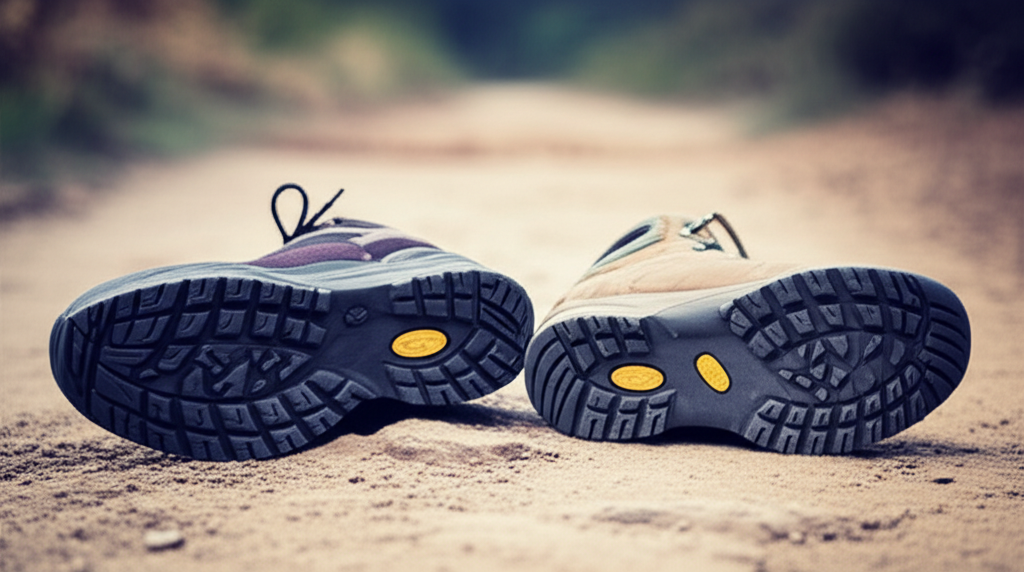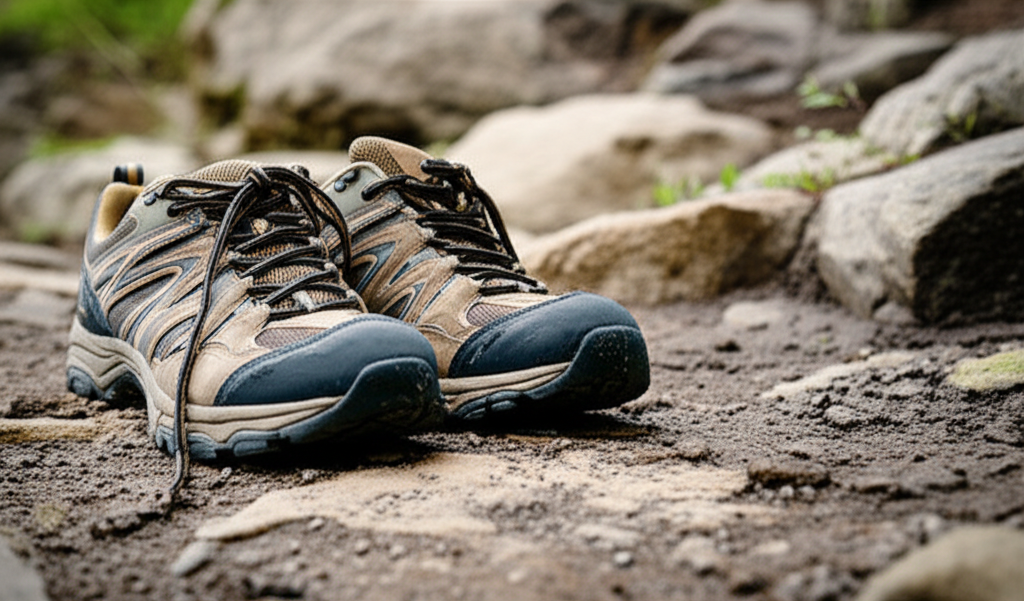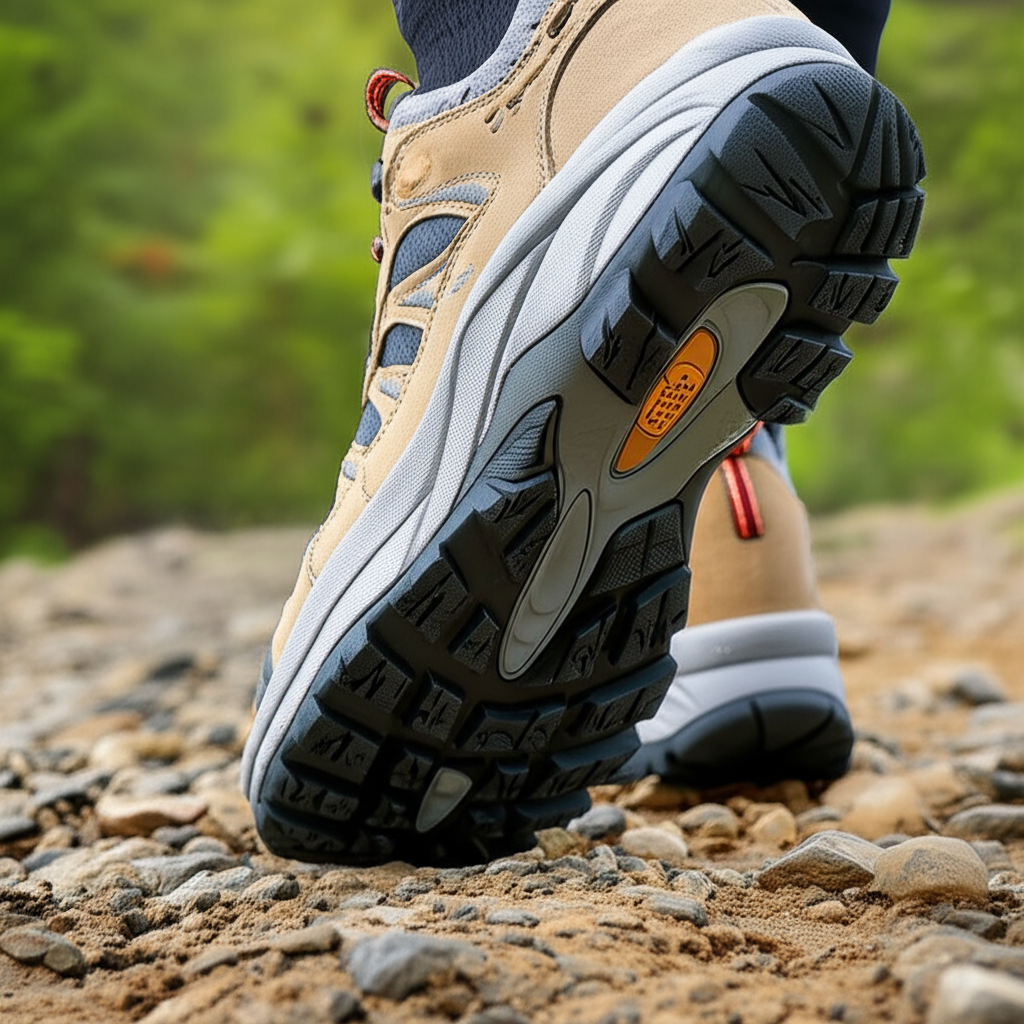While walking shoes can be used for very light, casual strolls on flat, well-maintained paths, they are generally NOT suitable for actual hiking. Hiking demands specialized footwear for safety, support, and comfort on uneven terrain. Using walking shoes for hiking can lead to discomfort, injury, and a poor experience.
Key Takeaways
- Walking shoes lack ankle support for trails.
- Hiking shoes offer better traction and durability.
- Understand your trail type for proper footwear.
- Invest in dedicated hiking shoes for safety.
- Proper footwear enhances hiking enjoyment.
- Prevent injuries with the right hiking boots.
Can Walking Shoes Be Used for Hiking? The Shocking Truth
Have you ever wondered if your comfy walking shoes are good enough for that scenic trail you’ve been eyeing? It’s a common question for many beginners stepping into the world of outdoor adventures. You love your walking shoes for everyday errands, so it seems logical they might work for a gentle hike. However, the truth might surprise you. Using the wrong footwear on the trail can turn a pleasant walk into a painful ordeal, or worse, lead to an injury. Let’s uncover the real differences between walking shoes and hiking shoes and determine when, or if, your walking shoes can keep up with your hiking ambitions.
Walking Shoes vs. Hiking Shoes: What’s the Difference?

It’s easy to get confused between different types of athletic footwear. After all, they all cover your feet, right? But when you’re hitting the trails, even a short one, the demands placed on your shoes are significantly different from those of a paved sidewalk. Walking shoes are designed for comfort and support during repetitive, forward motion on flat, predictable surfaces. Hiking shoes, on the other hand, are built to tackle varied, unpredictable terrain, offering protection, stability, and grip.
Let’s break down the key design elements that set them apart:
Sole Construction: Grip and Durability
The sole is arguably the most critical component differentiating walking and hiking shoes. For walking shoes, the outsole is typically made of rubber with a relatively shallow tread pattern. This design provides good traction on smooth surfaces like pavement or indoor floors. The midsole is often cushioned for shock absorption, which is great for absorbing impact on hard surfaces. However, this cushioning can also make the shoe less stable on uneven ground.
Hiking shoe outsoles are a different story. They are engineered with deep, aggressive lugs (the raised patterns on the sole) made from durable rubber compounds. These lugs are designed to bite into loose dirt, mud, gravel, and rock, providing superior traction and preventing slips. The sole is also often stiffer, offering more support and preventing your foot from feeling every sharp rock underfoot. This stiffness is crucial for reducing foot fatigue on long hikes.
Consider this: a study by the National Park Service highlights the importance of trail surface and how footwear plays a role in minimizing trail impact and user safety. Aggressive treads on hiking boots are designed precisely for these varied natural surfaces.
Ankle Support: Stability and Injury Prevention
One of the most significant differences is ankle support. Most walking shoes are low-cut, meaning they only cover the foot up to the ankle bone. This offers flexibility but provides no protection or stability for the ankle joint itself. When hiking, especially on rocky or uneven trails, you’re at a much higher risk of rolling your ankle. A sprained ankle can be painful and sideline you for weeks.
Hiking footwear comes in various cuts, including low, mid, and high-top designs. Mid-cut and high-top hiking boots extend above the ankle bone, offering crucial support and protection. This added structure helps to stabilize the ankle, reducing the likelihood of twists and sprains. Even low-cut hiking shoes often have a more robust upper construction around the ankle than walking shoes, offering a bit more lateral support.
Materials and Construction: Protection and Breathability
The upper materials of walking shoes are often made from mesh, knit fabrics, or lightweight synthetic materials. These are chosen for breathability and flexibility, keeping your feet cool and comfortable during a walk. While some walking shoes might have water-resistant treatments, they are generally not waterproof.
Hiking shoe uppers are built for durability and protection. They often incorporate tougher materials like leather, suede, or synthetic blends that can withstand abrasions from rocks, roots, and branches. Many hiking shoes also feature waterproof and breathable membranes, such as Gore-Tex, which keep your feet dry from external moisture (like rain or puddles) while allowing sweat vapor to escape. This is vital for preventing blisters and maintaining comfort in changing weather conditions.
Cushioning vs. Stability
Walking shoes prioritize plush cushioning. This is excellent for absorbing the repetitive impact of walking on hard surfaces. However, excessive cushioning can sometimes lead to a less stable feel on uneven terrain. If a shoe is too soft and flexible, your foot can sink into it, making it harder to balance on rocks or roots. Your foot muscles also have to work harder to stabilize themselves, leading to quicker fatigue.
Hiking shoes strike a balance between cushioning and stability. They have enough cushioning to absorb shock, but their construction prioritizes a stable platform. This often means a firmer midsole and a shank (a stiff piece of material embedded in the midsole) that provides torsional rigidity, preventing the shoe from twisting too easily. This rigidity helps your foot maintain a stable position on uneven ground.
When Can Walking Shoes Potentially Work for a “Hike”?
Let’s be clear: for true hiking, dedicated footwear is best. However, there are very specific, limited scenarios where you might get away with using walking shoes. These are essentially glorified walks in nature, not strenuous hikes.
- Paved Nature Trails: If your “hike” is on a well-maintained, paved path, like those found in many city parks or accessible nature centers, your walking shoes will likely be fine. These surfaces are predictable and similar to sidewalks.
- Extremely Gentle, Flat Trails: For very short, flat, and smooth dirt paths with no rocks, roots, or significant inclines, a sturdy pair of walking shoes might suffice. Think of a leisurely stroll through a botanical garden or a flat forest loop.
- Light Load: If you’re only carrying a very small, light daypack with essentials (water bottle, snack), the added weight won’t put as much stress on your footwear.
Even in these situations, it’s worth noting that dedicated walking shoes designed for trail walking (often called “trail runners” or “light hikers”) will still offer superior grip and durability compared to your everyday walking shoes.
The Risks of Using Walking Shoes for Hiking

Now, let’s talk about the “shocking truth” – the real dangers and drawbacks of using inappropriate footwear on the trail. When you venture onto uneven, natural terrain with shoes designed for flat surfaces, you’re setting yourself up for problems.
1. Increased Risk of Slips and Falls
As mentioned, walking shoe treads are not designed for loose dirt, mud, or wet rocks. The shallow patterns offer very little grip, making it easy to slide, especially when going downhill or traversing slippery sections. This can lead to falls, which can range from minor scrapes to serious injuries.
2. Ankle Sprains and Injuries
The lack of ankle support in most walking shoes is a major concern. Your ankle is a complex joint, and it needs stability when navigating obstacles like roots, rocks, and uneven ground. Without the support of a higher-cut shoe or a more rigid sole, your ankle is far more prone to rolling, leading to painful sprains or even more severe ligament damage.
3. Foot Pain and Blisters
Hiking involves prolonged periods of walking, often with more force and on less forgiving surfaces than you encounter daily. The lighter cushioning and less supportive structure of walking shoes might feel comfortable initially, but they can lead to foot fatigue, arch pain, and even conditions like plantar fasciitis over time. Furthermore, the friction generated by your foot sliding inside a less supportive shoe on uneven terrain is a recipe for blisters.
4. Lack of Protection from Debris
Hiking trails can be littered with sharp rocks, roots, and other debris. Walking shoes often have thinner soles and less protective toe caps. This means you’re more likely to feel sharp objects through the sole or stub your toes on obstacles, which can be very uncomfortable and potentially cause injury.
5. Reduced Hiking Performance and Enjoyment
When your feet are uncomfortable, unstable, or aching, your entire hiking experience suffers. You’ll likely walk slower, be more cautious, and find it harder to enjoy the scenery. The mental and physical toll of dealing with foot issues can quickly overshadow the pleasure of being outdoors.
What to Look for in Proper Hiking Footwear
Now that we understand the risks, let’s focus on what makes good hiking footwear. The best choice depends on the type of hiking you plan to do. Here’s a breakdown:
Hiking Shoes
These are low-cut shoes, similar in height to walking shoes, but built with hiking in mind. They are ideal for:
- Day hikes on well-maintained to moderately challenging trails.
- Hikers who prefer a lighter, more flexible feel.
- Carrying lighter loads.
Look for:
- Durable outsole with aggressive lugs.
- Stiffer midsole for support.
- Protective toe cap.
- Breathable and water-resistant or waterproof materials.
Day Hiking Boots
These are mid-cut boots that offer more ankle support than hiking shoes. They are suitable for:
- Day hikes on varied terrain, including moderate inclines and descents.
- Hikers who want extra ankle stability.
- Carrying moderate loads.
Look for:
- All the features of hiking shoes.
- Higher ankle collar for support.
- More robust construction for durability.
Backpacking Boots
These are high-cut, sturdy boots designed for carrying heavy loads on multi-day trips over challenging terrain. They offer maximum ankle support and durability. They are suitable for:
- Backpacking with heavy packs.
- Trekking over rugged, off-trail terrain.
- Hikers needing maximum support and protection.
Look for:
- Stiff sole and shank for stability under heavy load.
- Full-height ankle collar.
- Durable, often leather, construction.
- Excellent waterproofing.
A great resource for understanding the different types of hiking footwear and their intended uses can be found on websites like REI’s Expert Advice section, which offers comprehensive guides for outdoor gear.
Choosing the Right Footwear for Your Trail Type
The “best” hiking shoe isn’t a one-size-fits-all answer. It depends heavily on the terrain and conditions you’ll encounter. Here’s a quick guide:
| Trail Type | Recommended Footwear | Key Features to Look For |
|---|---|---|
| Paved Paths / Very Flat & Smooth Dirt Trails | Sturdy Walking Shoes or Trail Runners | Good cushioning, decent grip, comfortable fit. |
| Well-Maintained Trails (some roots/rocks) | Low-Cut Hiking Shoes or Trail Runners | Aggressive lugs, moderate stiffness, toe protection, water-resistance. |
| Moderately Rugged Trails (uneven terrain, moderate inclines) | Mid-Cut Day Hiking Boots | Ankle support, stiffer sole, durable materials, good traction, waterproofing. |
| Challenging Terrain (rocky, steep, off-trail, carrying heavy packs) | High-Cut Backpacking Boots | Maximum ankle support, very stiff sole, robust construction, superior waterproofing. |
Understanding your typical hiking environment is key. If you’re just starting and sticking to local park trails that are mostly flat and packed, a good pair of trail running shoes might be a great starting point. They offer more grip and durability than standard walking shoes but are lighter than boots.
Pro Tips for Footwear Selection
Pro Tip: Always try on hiking shoes or boots later in the day when your feet are slightly swollen, mimicking how they might feel after a few hours on the trail. Wear the type of socks you plan to hike in. Ensure there’s about a finger’s width of space between your longest toe and the front of the shoe when standing. Walk around the store, go up and down inclines if possible, and pay attention to any pressure points or rubbing.
Break-In Period: A Crucial Step
Unlike many walking shoes that feel comfortable right out of the box, hiking boots often require a break-in period. This is especially true for stiffer, more durable models made of leather. Wearing them for short walks around your neighborhood or on easy local trails before a big hike allows the materials to soften and conform to your feet. This process helps prevent blisters and hot spots on your actual hike. Even lighter hiking shoes can benefit from a few wears to ensure a perfect fit.
FAQs About Walking Shoes and Hiking
Can I wear my regular sneakers for a short hike?
For a very short, flat, and well-maintained trail, your regular sneakers might be okay, but they won’t offer the grip or support needed for true hiking. You risk slipping or experiencing discomfort. It’s always safer to opt for footwear designed for trails.
Are trail running shoes good for hiking?
Yes, trail running shoes are often an excellent choice for hiking, especially for day hikes on moderate terrain. They offer better traction and durability than walking shoes, are lighter than boots, and provide good flexibility. They are a great compromise for many hikers.
How important is waterproofing in hiking shoes?
Waterproofing is very important if you hike in wet conditions, through streams, or in rainy weather. Waterproof shoes keep your feet dry, which prevents blisters, keeps you warmer, and makes the hike much more comfortable. However, waterproof shoes can be less breathable in hot, dry weather.
What happens if I wear walking shoes on a rocky trail?
On a rocky trail, walking shoes offer minimal protection. You’re likely to feel every sharp rock through the thin sole, leading to foot pain. The lack of ankle support also significantly increases your risk of twisting an ankle on uneven rocks.
Can I use gym shoes for hiking?
Gym shoes (like cross-trainers or indoor court shoes) are designed for lateral stability and grip on smooth indoor surfaces. They generally lack the durable outsole tread, underfoot protection, and ankle support needed for hiking trails. It’s not recommended.
How often should I replace my hiking shoes?
The lifespan of hiking footwear varies depending on the quality, how often you use them, and the terrain. Generally, hiking shoes and lighter boots might last 500-800 miles, while heavier backpacking boots can last longer. Look for signs of wear like worn-out treads, compressed midsoles, or damaged uppers.
Do I need to break in hiking boots?
Yes, most hiking boots, especially those made of leather or with stiffer construction, benefit significantly from a break-in period. Wear them for short walks to allow them to mold to your feet and identify any potential hot spots before undertaking a long hike.
Conclusion
So, can walking shoes be used for hiking? The answer, for most practical purposes and for your safety and comfort, is a resounding no. While they might get you through a very casual stroll on a paved park path, they are fundamentally unsuited for the demands of natural trails. The lack of aggressive traction, ankle support, and robust protection makes them a poor choice that can lead to discomfort, blisters, and potentially serious injuries like sprained ankles. Investing in a pair of dedicated hiking shoes, trail runners, or hiking boots is not just about comfort; it’s about safety, performance, and ultimately, enjoying your time in the great outdoors. Choose wisely, and happy trails!

